How do you think about 5.5G?

Hello everyone, I'm Xiaozaojun.
Some time ago was the anniversary of the domestic 5G licensing on June 6, and the R17 standard was frozen on June 9, so the industry was very lively and there were many activities.
These intensive commercial activities have spawned a large number of news reports, which have attracted the attention of the whole society to 5G, 5.5G, 5G-Advanced, R17, and R18.
For laymen, it will be more confusing-
What is 5G-Advanced? What is 5.5G? Why not 6G? What is the difference between 5.5G and 5G? …
Today, I will try to use the method of "speaking people's words" to tell everyone the ins and outs of 5.5G.
What exactly is 5.5G
5.5G, as everyone should know, is actually the transition stage between 5G and 6G.
As we all know, mobile communication technology is almost every ten years generation.
However, because the technology is developing so fast, the technology difference between the integer generation and the integer generation is too great. At this time, it is necessary to name the technology in the intermediate stage to show the difference from the previous generation and the offspring.
This kind of gameplay started as early as 2/3G. GPRS was once called 2.5G, which is between 2G GSM and 3G UMTS. Between 3G and 4G, there is an even more outrageous 3.75G, which is EDGE.
When LTE appeared, it was also called 3.9G because the technical indicators did not meet the requirements of ITU for 4G. Later, based on LTE, LTE-Advanced was developed, which is the real 4G.
Before 5G was born, the industry also had names such as 4.5G and pre5G, but the time was very short and it was short-lived.
This time, based on the evolution of 5G, people continue to use the previous habits, so it is named 5.5G. In fact, the essence of 5.5G is 5G-Advanced.
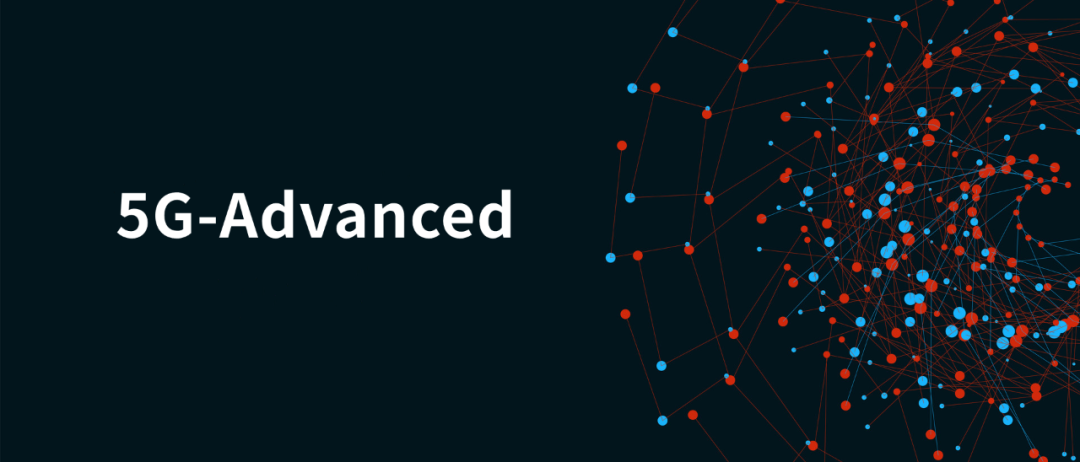
Students who are familiar with the communication industry know that 3GPP, the international standards organization, promotes technology evolution research by continuously releasing Releases (versions). Each Release includes a bunch of technologies. Everyone desperately held a meeting to discuss and finalize the technical details, and then voted to pass, even if the Release was frozen.
As for this Release, it comes out almost every two years. However, the communication network standard is also a generation every ten years or so. That means that each integer generation will go through about 5-6 Releases.
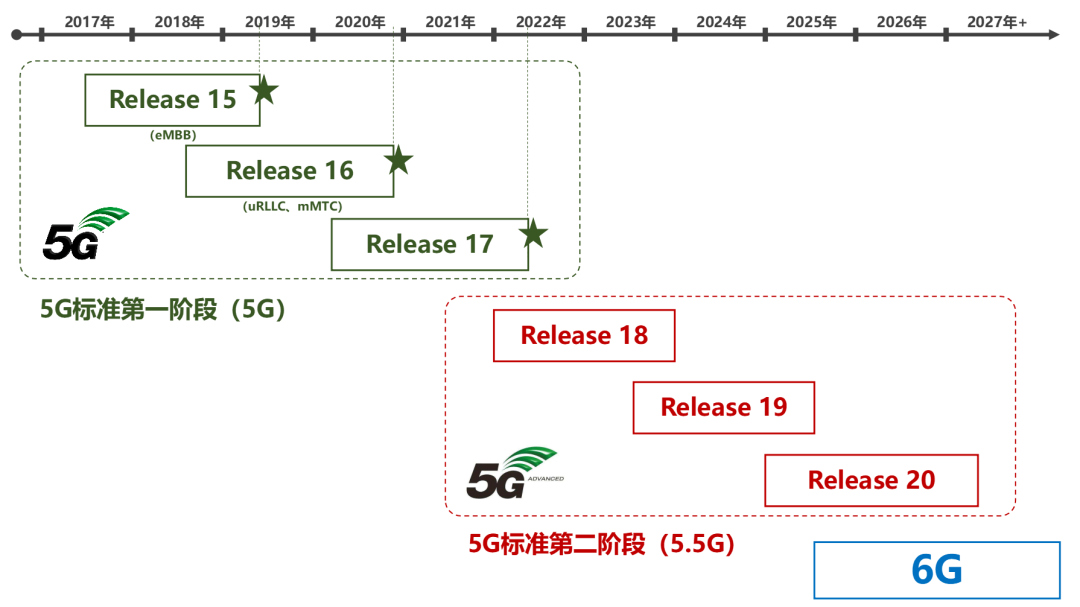
The emergence of 5.5G this time is actually to use R15-R17 as the first stage of the 5G standard, and R18-R20 as the second stage of the 5G standard for subdivision. After the end of R20, almost 6G will appear (around 2028-2030).
Therefore, 5.5G (5G-Advanced) is the transition and connection between 5G and 6G, which will probably last for more than 5 years.
5G-Advanced was officially named the name of the 5G evolution in April 2021. In December 2021, the 3GPP SA2 plenary meeting voted to determine 28 research topics in the R18 version, which is equivalent to determining the first wave of key technologies for 5G-Advanced.
Xiaozaojun pointed out that the R18 freeze should be at the end of 2023, or even the first half of 2024 (considering the uncertainty of the epidemic). Coupled with the version freeze, it will take at least a year for the industry to mature.
Therefore, when everyone really sees the landing of 5G-Advanced, it will also be in the first half of 2025. There are still three years left, so don't worry too much.
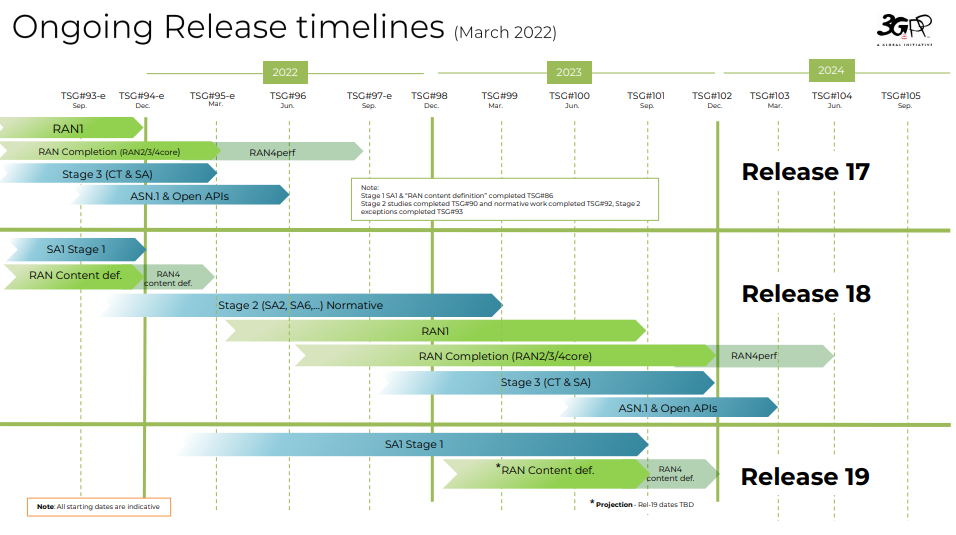
Time-point planning for R18 (picture from 3GPP)
What does 5.5G include?
After talking about the 5.5G timeline, let’s take a look at what new content 5.5G has.
In fact, 5.5G is a transition, and it is impossible to have any disruptive changes. Even if it is 6G, there is no shadow of "shocking" black technology at present.
There are two main missions of 5.5G:
The first is to check for omissions and fill in the gaps, correct and strengthen the areas where 5G is insufficient. The second is to open a new copy. According to the development and changes of the industry, take a look at the hot spots and step on the thunder in advance for 6G.
The current development of 5G, frankly speaking, is divided into half and half.
After three years of commercial use, a lot of money was spent, and the network was basically built. With more than 1.6 million stations, more than 400 million users, and 100% coverage in prefecture-level cities, the results can be described as dazzling.

However, in terms of the C-side user experience, users did not report significant differences in perception. 5G did not get the expected praise, but also took the blame for 4G speed limit.
On the side of B-end users, 5G is still in a state of anxiety. Although the number of industrial application cases has reached more than 20,000, it is still dominated by head users who focus on centralized resources. Many construction funds also come from government investment. To put it bluntly, 5G is still "Wang Xietang Qianyan", not flying into "ordinary people's homes".
The problem of 5G involves many factors such as chip cost, external macro environment, and enterprise's own management. I have said it before, and I will no longer beep today.
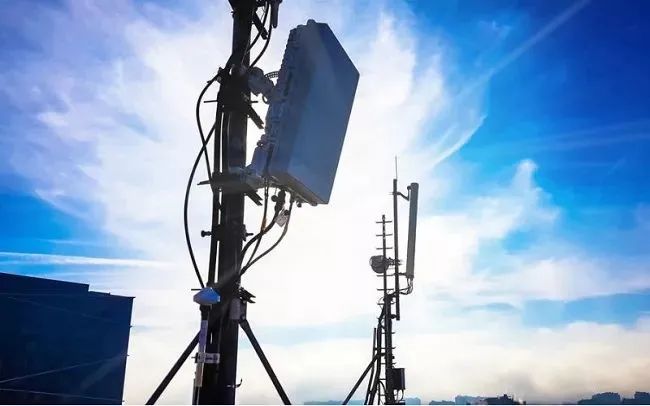
5.5G, as the technological evolution of 5G, cannot solve the non-technical problems that plague the development of 5G. Therefore, it can only choose to turn a blind eye, solve technical problems, and do what can be done.
What can be done technically? To put it bluntly, it is still the same as speed, latency, connection scale, and energy consumption. Continue to tap the potential in technical indicators and continue to squeeze toothpaste.
On the basis of 5G ubiquitous gigabit experience and tens of billions of connections, 5.5G will further upgrade the indicators to: ubiquitous 10-gigabit experience, 100 billion connections.
Specifically, 5G-Advanced will have to achieve peak rates of downlink 10 gigabit (10Gbps) and uplink gigabit (1Gbps), as well as millisecond-level latency and low-cost Internet of Things.
In order to meet the increasingly hot positioning needs (especially indoor positioning), 5G-Advanced also emphasizes that it will have stronger terminal perception capabilities and high-precision positioning capabilities. These capabilities mean that 5G is no longer limited to connection technology, but beyond the scope of communication.
In order to reflect the difference between 5.5G and 5G, experts and manufacturers have also upgraded the traditional 5G scene triangle and turned it into a hexagon. Newly added are UCBC (Uplink Ultra Wideband), RTBC (Broadband Real-Time Interaction) and HCS (Communication Awareness Convergence).
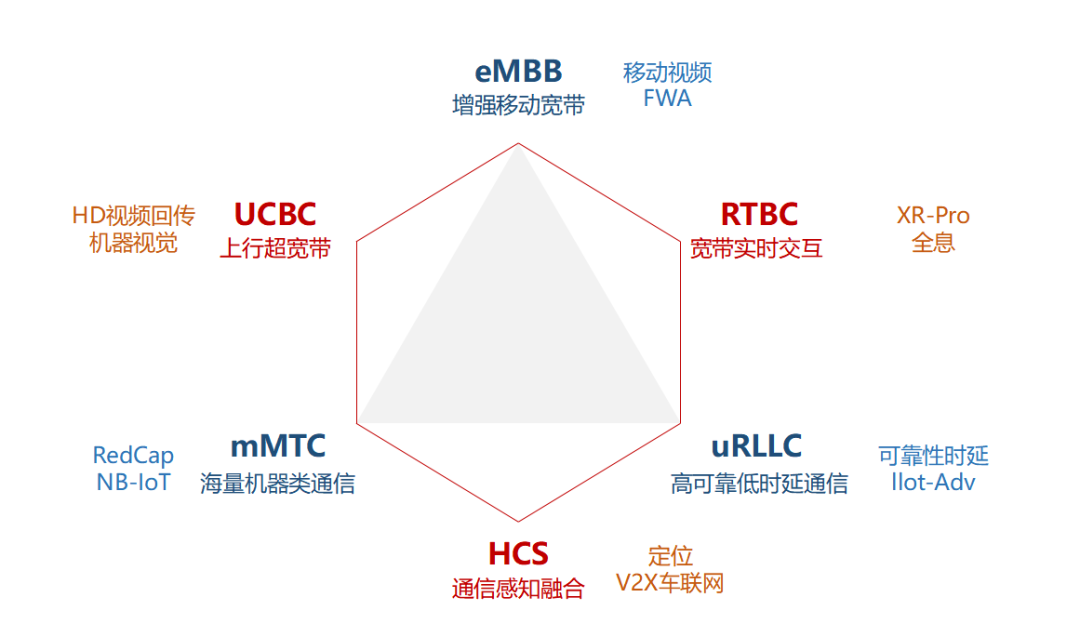
To be honest, in addition to the HCS communication perception fusion, UCBC and RTBC should actually be in the category of eMBB (Extra Large Bandwidth).
5.5G technology evolution route
Let's take a look at the key technologies of 5.5G in detail.
First look at the rate. The speed is the first indicator of the communication network, and it is also the object that people pay attention to.
In the absence of a breakthrough in the current electromagnetic theory, all the speed advantages of 5G are actually obtained in exchange for spectrum bandwidth.
Just like farming, with such a large field, no matter how carefully you take care of it, using pesticides, fertilizers, and miscellaneous rice, its output is limited.
The modulation methods are already 256QAM and 1024QAM, and further up, the requirements for channel conditions are too high, and the consumption of computing power algorithms is also very large. Multiple access multiplexing, channel coding, and everything that should be used are also used, basically approaching the Shannon limit, and there is really not much room for improvement.
The only thing left to do is to make a fuss about the spectrum.
Or, to engage in dynamic spectrum sharing is actually to "revitalize" the existing spectrum, and flexibly borrow the 3G/4G spectrum to 5G to enhance the bandwidth.
Or, engage in carrier aggregation and use co-construction and sharing to gather all the spectrum in your hands to improve bandwidth.
In order to grab the spectrum, 3GPP also focused on the Wi-Fi frequency band, planning to grab some spectrum to use in the free frequency bands such as 2.4GHz and 5GHz. This is 5G NR-U (5G NewRadio in Unlicensed Spectrum).
The bigger coveted target for 5.5G is the 6GHz band. Everyone wants this piece of fat, including Wi-Fi 6E and Wi-Fi 7, so the competition is fierce.
If operators want to achieve the peak rate of 5.5G downlink 10 Gigabit, they must upgrade the currently owned spectrum resources from the 100-megahertz level to the gigahertz level.
Judging from our country's preference for cellular networks and advocating the dominance of state-owned enterprises, the probability of operators getting the domestic 6GHz frequency band is still very high.
In addition, our available frequency band resources in this range (intermediate frequency) are indeed very few. If operators do not grab the 6GHz frequency band, there will be no way out in the future.
In addition to the downlink, another outstanding issue regarding the rate is the uplink.
With the emergence and outbreak of large uplink business demands such as video surveillance backhaul, high-definition video live broadcast backhaul, and 3D modeling and cloud rendering, experts in the communications industry suddenly found that they had insufficient estimates of the 5G uplink demand and insufficient reserved bandwidth. .
The frame structure design of 5G can be changed. However, generally speaking, there is an 8:2 relationship between down and up. The frame is actually the carriage, 8 carriages are used to carry goods downwards, and 2 carriages are used to carry goods upwards.
This is based on the common data consumption habits of our mobile Internet. Everyone thinks about it and understands that most of our time is watching videos, web pages, and playing games. Therefore, the demand for downlink data is significantly greater than that of uplink (upload).
In order to solve this problem, there are two ways: one is the uplink and downlink decoupling (link) that I introduced before, which is to use a low frequency band with stronger coverage for uplink, and then high frequency for downlink. The other is to make a fuss about frame allocation, use more frames for uplink, and change the ratio of uplink and downlink.
It is worth mentioning that, to solve the problem of delay, it is mainly about frames and time slots. If the frame becomes smaller and more flexible, which is equivalent to changing the car into a motorcycle, the delay value of the air interface can be reduced.
In order to realize the uplink and downlink requirements more flexibly, 3GPP also engages in flexible duplexing on the basis of traditional FDD and TDD, and fiddles with XDD, that is, FDD and TDD are mixed together. For example, "downlink frequency division, uplink time division", the flexibility is maximized, and you can be happy.
After "frequency spectrum for bandwidth", coverage problems are inevitable.
I have repeatedly mentioned in my previous articles that the higher the frequency band, the shorter the wavelength, the poorer the diffraction ability, and the shorter the coverage distance. 2.6GHz, 3.5GHz, 4.9GHz, each has poorer coverage than the other, and the 6GHz they want to grab has worse coverage.
Therefore, to solve the coverage problem, we have to do a lot of articles.
At present, the main research and development direction is antenna technology.
Huawei's boss said that the 6GHz frequency band has 7 dB more loss in space propagation loss than the 2.6GHz frequency band. To make up for this loss, it is necessary to build a super-ultra-large-scale antenna array that is more powerful than the current Massive MIMO.
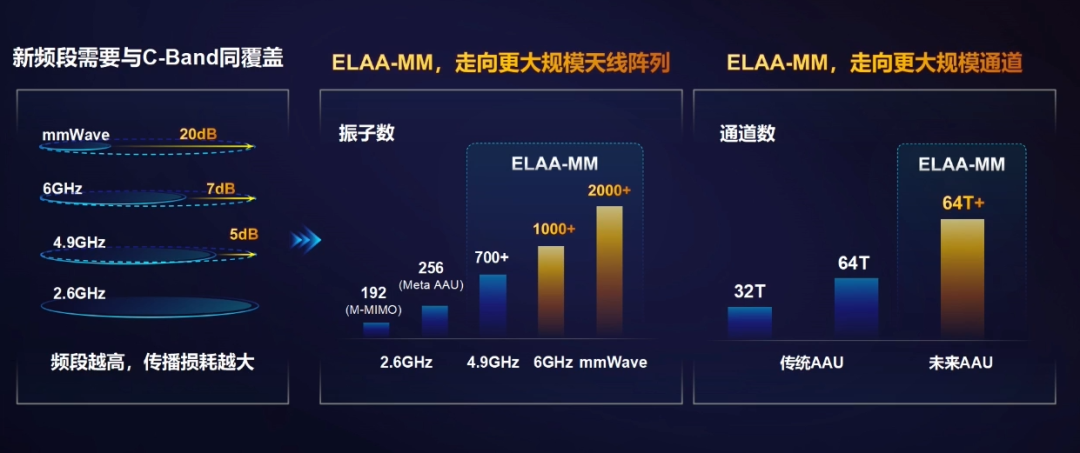
Picture from Huawei, ELAA-MM is Massive MIMO
192/256 vibrators are not enough, and it can be done directly to more than 700 or even 1000 vibrators. The number of channels will also soar, with more than 192.
The greater the number of oscillators, the more powerful the beamforming, the more flattened the wave is, and the greater the coverage distance.
There are really not many tricks that can be played in the air. The core network indicators of 5.5G and even 6G basically rely on spectrum and frame structure, and the road ahead is slim.
But having said that, I am still very suspicious of how many 10 Gigabit downlink scenarios are. Last year, the cloud universe exploded, driving the XR industry. Even XR doesn't use 10 Gigabit.
The 10 Gigabit demand may exist, and all I can think of is holographic communication. To be honest, I think this thing is still very far away.
After talking about the wireless air interface, let's look at other things.
Not to mention the bearer network, the transmission technology has always been played by itself, and it has nothing to do with 3GPP, and 5.5G is not mentioned much. To understand this part of the knowledge, you can read my previous analysis of the evolution of transmission technology.
Focus on the core network.
In 5.5G, the development direction of the core network is still the old-fashioned "cloud-network integration" and "cloud-network integration". Now the computing power network is very popular, and there are some subtle changes that drive the development trend of 5G cloud core network.
5G has already realized the cloudification and virtualization of the core network. The SBA architecture has already taken shape. From the effect point of view, the benefit is not very obvious. According to my personal opinion, it is still pseudo-virtualization and strong binding of manufacturers.
What operators are doing is convergence. That is to say, the 2/3/4G core network is fully integrated into the 5G cloud core network, which simplifies the network architecture and reduces the burden of network operation and maintenance.
Under the general trend of cloud-network integration, operators have the urge to completely merge the telecom cloud with the Internet cloud, but the pace is a bit big, and they are not too daring to do so. After all, the telecommunications business is the foundation of its own, and if something goes wrong, it cannot afford this responsibility.
On the basis of existing cloudification, operators are also considering to further promote cloud native, hoping to make their cloud more flexible and more suitable for development and testing. Another advantage of cloud native is that it can further improve the utilization of hardware resources through software optimization, which is to improve the return on investment (or to save money).
The in-depth cloudification of the core network is said to be a prerequisite for the realization of endogenous network security.
I don't know much about endogenous safety, but I've always felt that this concept is more dangling. I think all security should be based on computing power. It is unimaginable that security can be achieved simply by designing and improving the architecture. (Dedicated to this topic another day.)
When it comes to cloud core network, we have to mention edge computing.
Edge computing is the sinking of cloud computing power, which opens the door to a whole new world for operators. Operators suddenly discovered that computing power can be deployed on each node of their own network. As a result, many application scenarios have been hatched. Especially in the direction of enterprise toB private network, edge computing can meet the requirements of many low-latency and large-bandwidth scenarios, so it has broad development prospects.
Both Internet manufacturers and operators are eyeing the big cake of edge computing. Operators have networks in their hands, and Internet manufacturers have cloud technology in their hands, so they have each other's defenses.
There is a technology that has been implemented in wireless access networks, bearer networks, and core networks, and is currently a hot research topic in the communications industry, that is AI artificial intelligence.
AI is a panacea. It is a form of expression of computing power.
The technologies in all aspects of the communication field are, in the end, mathematics and computation. For example, high-order modulation (above 1024QAM), such as wireless network optimization and simulation, such as path planning of bearer network SDN, and another example of core network slicing and resource scheduling.
In the 5.5G stage, various communication companies will continue to strengthen their investment in AI. Some are to implement stronger algorithms, improve network indicators, and improve user experience. Some are to develop models, optimize the network, realize network self-management and self-failure recovery, and reduce network operation and maintenance costs. Some are to save energy, judge load changes, and dynamically adjust power.
In the next few years, it is believed that there will be a large number of "AI + communication" cases, and the network operation and maintenance model may undergo subversive changes. In addition to enhancing its existing capabilities, 5.5G is also trying to explore more application areas.
Among them, high-precision positioning, ranging and perception enhancement are included. This type of demand mainly comes from vehicle location management, logistics tracking and asset management. The main application directions are indoor scenarios that cannot be covered by satellites, and high-precision scenarios that cannot be achieved by satellites and other technologies.
Experts envision that 5G is not only used for communication, but can also sense the environment like radar, capture and measure the distance, speed and shape of the target object. This is called "synesthesia integration".
Aerospace integration is also the focus of 5.5G research. Due to space limitations, let’s talk about it another day, and dig a hole first.
Finally, I want to talk about passive IoT.
As I said earlier, 5.5G is also a hot spot, the Metaverse and the passive Internet of Things.
I've covered passive IoT in detail before (link). In fact, to put it bluntly, the terminal does not have a power supply or battery. Through the network, "irradiate" the terminal, and let the terminal sense the "irradiation" of the network like the bus card RFID technology, and respond to feedback data.
It has the advantages of low cost, zero power consumption, and easy deployment. In the future, all our retail products may be equipped with passive IoT technology to realize the management of goods by merchants.
This technology is not as simple as imagined. In addition to the need for a more concise protocol for the air interface, there is a lot of work to be done in security authentication and network architecture optimization. There are also many potential competitors for 5.5G, and in terms of passive Internet of Things, they do not necessarily have an advantage.
Epilogue
Okay, so much has been said, everyone should know something about 5.5G. There are actually many more key technologies, but I have basically mentioned the general direction.
The development ideas of 5.5G are basically the same as our predictions when we judged 6G in the past few years.
In a nutshell, it is capability enhancement, introduction of AI, and functional integration. Make yourself stronger, easier to maintain, greener, more cost-effective and labor-saving, so that you can better play the value of your connection power, serve computing power, and serve digital transformation.
R18 is on the road now, let's wait and see where 5.5G will go.